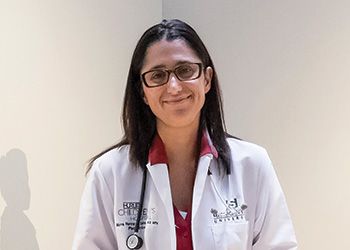A Voice for the Smallest: The Flint Water Crisis

On a cold, snowy February morning, a little boy in the waiting room at Hurley Medical Center Children’s Clinic sidled up to his mom and whispered in her ear.
She replied in a hushed tone. “Because,” she said, “you drank the water.”
“No,” he whimpered. “I didn’t. I didn’t drink the water!”
This mother, and hundreds more in Flint, were bringing their children into clinics largely to see Hurley pediatrician Dr. Mona Hanna-Attisha, also an assistant professor of pediatrics and human development at MSU’s College of Human Medicine.
Residents and public employees in Flint had been voicing concerns about their water quality for months, bringing bottles of foul-looking liquid to city council meetings to protest. But no one would listen.
Hanna-Attisha refused to be ignored—and she had research on her side. “University research funding is vital to uncovering and exposing big problems like this,” she said.
Hanna-Attisha had analyzed data from the routine blood tests given to children in Flint. “We saw that percentages of elevated lead levels were doubling, sometimes tripling across the city,” she said. “And no one was doing anything about it.”
The doctor and her team soon realized that the data correlated with the city changing the source of its water supply. Fearing a widespread health emergency, Hanna-Attisha shared the findings with the region’s public health officials. They agreed that residents needed to be informed immediately that there was lead in the water they drink, cook with and bathe in.
That was last September. “On (a) Monday we brought our research to the city. We told them it had to be released by Wednesday or we would release the information (ourselves) on Thursday,” Hanna-Attisha said.
The city failed to act.
So on that Thursday the pediatrician put on her crisp white coat and, with health officials by her side, held a news conference that revealed to the world the extent and duration of Flint’s noxious water problem and its injurious effects.
Initially, government officials tried to discredit the research findings, accusing the doctor of wrongly sending residents into “near hysteria.”
“Fortunately, all that only lasted about two weeks,” Hanna-Attisha, 40, recalled in a recent interview at Hurley. “Eventually, they came around to say, ‘Hey … you were right.’”
By the end of that year, the controversy was national news. Media organizations including CNN, The New York Times, The Washington Post, USA Today, MSNBC’s Rachel Maddow and The Boston Globe sought interviews with Hanna-Attisha. There were days when she granted 10 media interviews. Reporters flocked to Flint, where Hanna-Attisha took them on tours of Hurley. In between, she answered flurries of emails about the crisis.
Shortly after, the U.S. Congress requested that the doctor and others appear at a federal investigatory hearing in Washington, D.C., on the situation.
Praise has come in for the doctor’s courage. “There aren’t many people who can go this path. It takes an enormous personal toll,” Marc Edwards, a civil/environmental engineer and professor at Virginia Tech whose water tests helped unravel Flint’s woes, told In-Training, an online magazine for medical students. “For Dr. Mona, it worked out. I cannot say enough in praise of her, and it gives me great hope that she’s getting the accolades she deserves.”
For Hanna-Attisha, it’s all part of the job. “Innately, pediatricians are activists,” she said. “We give immunizations, tell people to wear their seatbelts, have babies sleep on their backs. We work with families, we work with communities, we go to the Capitol and we advocate.”
Drawn to service
Hanna-Attisha said she fell in love with pediatrics during her time as an MSU medical student at Hurley. Her pediatric experience includes a residency at Children’s Hospital of Michigan, part of the Detroit Medical Center.
Hanna-Attisha, who immigrated to the United States with her Iraqi parents when she was 5, grew up in Royal Oak. She said she’s particularly interested in helping those in underserved communities. She purposefully chose Flint—where more than 40 percent of residents live at or below the poverty line—when she pursued her medical school education.
Dubbed “Dr. Mona” by the Flint community in the aftermath of her news conference, she directs Hurley’s pediatric residency program and teaches at MSU’s Department of Pediatrics and Human Development in the city.
“I chose (to attend) MSU for its service mission in underserved communities and for its altruism, ethics and professionalism,” she said. “When you’re an educator, the results are multiplicative. I want to instill this (advocacy work) in the next generation of pediatricians and public health professionals.
“That’s what a land-grant university is all about.”
A crisis unfolds
For two years, an estimated 8,000 Flint children under the age of six, along with other city residents, lived in homes where lead-contaminated water flowed from faucets. Many of these children have undergone sometimes painful blood draws in recent months.
Children, because they’re still developing, are extremely susceptible to lead poisoning. Lead exposure can cause irreversible neurological damage, lower intelligence and manifest itself as aggressive behavior later in life.
The problem began in 2014 when the city, on the cusp of bankruptcy and under a state-appointed emergency manager, switched its water supply from Lake Huron to the Flint River. The river water required treatment with anti-corrosives to flow safely through the city’s older pipes. Authorities failed to take this step, allowing lead to leach from municipal pipes into drinking water.
As Hanna-Attisha told CNN, it was like “drinking through lead-painted straws.”
Residents soon began complaining. The crisis started to bubble up when a Flint mother asked that the water in her home be tested. That caught the attention of Edwards at Virginia Tech, who compared lead levels in Flint’s water with those of Lake Huron. The analysis found an alarming disparity with regions in the greater surrounding Genesee County area.
In the meantime, area doctors started hearing more patients complaining of nausea and pain.
Hanna-Attisha’s results from the blood test analysis confirmed the situation in August 2015. During a chance encounter the previous year, she’d spoken with a high school classmate— now a water engineer—who mentioned that Flint wasn’t using anti-corrosives in its water.
Suddenly, all of the dots connected.
Fighting a silent epidemic
In the wake of this crisis, there is a silent pediatric epidemic. There is no antidote or cure for lead poisoning. “Lead (exposure) is a problem of the future,” Hanna-Attisha said.
It will take about two decades before the full extent and breadth of children’s learning disabilities, loss of motor skills and increased aggression will be apparent.
But it’s crucial to start work now to ameliorate the crisis, experts said.
“We are throwing every single intervention to these kids and we’re doing it now,” Hanna-Attisha said.
In February, MSU and Hurley Children’s Hospital established an umbrella under which these and future efforts to help the children of Flint are organized. Hanna-Attisha is overseeing the efforts, formally known as the Pediatric Public Health Initiative.
The initiative continues assessment of research and long-term monitoring of the lead exposure in Flint’s kids, as well as advocacy and implementation of programs to help them. Hanna-Attisha considers all of this work to be crucial, and noted that MSU and Hurley are perfectly positioned as partners with so many arms of positive influence in the area.
She said the initiative aims to identify and track children suffering from lead exposure, provide medical care to all Flint residents, help create a pre-kindergarten education program, increase the availability of healthy foods that help block the body’s lead absorption and expand nutrition education.
“We owe it to these kids” to find ways to provide wrap-around services for them and their families, she said.
This work takes place at a clinic located centrally in Flint, near the major bus station, making it as easy as possible for patients to reach their regular check-ups. Encouraging this “long-term continuative care” and follow-ups with a primary care doctor is a major concern for Hanna-Attisha.
“The people of Flint already had every obstacle stacked against them,” the doctor said. “And these kids did nothing wrong. It’s time we refocus on the prevention of these issues.”
‘You can see the trauma in their eyes’
Although Hanna-Attisha is a prominent figure in bringing the Flint water crisis to light, she finds it just as important to remain hands-on in the field. “The interviews and the press conferences are nice, but this is my real job,” she said between appointments with her young patients.
The daily communication and face-to-face interaction with patients remain the most important aspect of her career.
Every day the doctor deals directly with the fears of her patients and their parents. She begins a routine check-up by playing with the children, her friendly persona shining through, getting them to laugh, smile and talk about school.
Then she turns her attention to the concerned parent, watching from the corner.
“What are you doing about the water?” she asks.
She inquires about the use of filters on taps at home and any concerns with children’s skin, rashes or irritable itching. Then she advises families to use bottled water as much as possible. The city even advises residents to use bottled water for bathing—something that just can’t work.
“No one knows what is going on,” Hanna-Attisha said of her young patients and their families. “It hasn’t been easy. It’s heartbreaking, you can see the trauma in their eyes. These are people who have experienced a governmental betrayal.”
But she remains hopeful for Flint, once one of America’s great auto manufacturing cities. “We put the world on wheels. We’re going to weather this and have a better future.”
All the while, Hanna-Attisha continues to teach physicians-to-be from MSU and other medical schools through Hurley Medical Center’s pediatric residency program, relaying her mission of service to her students.
Her husband is also a pediatrician; they have two young daughters. Being a mother herself, seeing the influence of people who care about the community resonates deeply with the doctor. It’s that aspect of family and community that drives her to never stop her education and outreach efforts.
“Doing this work guarantees a next generation of physicians who will espouse this work. MSU has had its footprint in Flint for over a hundred years. We are reinvesting in this population.”
New Health Initiative to Support Flint Children's Well-Being
Following the Flint community’s population-wide lead exposure, Michigan State University partnered with Hurley Medical Center to create a Pediatric Public Health Initiative aimed at helping affected families.
The partnership brings together experts from the fields of pediatrics, child development, psychology, epidemiology, nutrition, toxicology, geography, education and community workforce development. The Genesee County Health Department will also be working directly with MSU on the program.
Dr. Mona Hanna-Attisha will lead the collaborative effort. The projects will include expanding nutritional education and addressing the lack of access to healthy food options in affected areas. The joint venture is based in Flint at Hurley Children’s Hospital.
The Pediatric Public Health Initiative will employ evidence-based interventions for the community in response to the Flint water lead exposure. The team of experts hopes to build a model public health program to continue assessing and monitoring the welfare of Flint’s children.
Improved education, nutrition and medical care are key to the program’s success.
Additionally, university researchers on MSU’s Flint campus will continue the established mission of co-creating solutions with people in their own communities—long after the world’s attention has moved on.
A short-term turnaround in diet is ideal to help the children of Flint. It is no accident that Hurley Children’s Center was located one floor above the farmers market where staff members perform daily cooking demonstrations for recipes that can help alleviate lead and make children less susceptible to its harmful effects.
The dieticians use recipes—high in vitamin D, calcium and iron-rich foods, all of which can help block lead absorbtion in the body—from a booklet published by MSU’s Extension and Hurley Children’s Hospital.
“We can’t go back in time,” Dr. Mona Hanna-Attisha said. “These kids need the benefits of nutrition now. Flint is resilient—it has so much pride. We have to do this. We owe it to our kids.”
MSU's Flint Campus Provides Medical Education, Public Health Research
The College of Human Medicine has educated medical students at Flint area hospitals since 1969. In 2014, the college received a $9 million gift from the Charles Stewart Mott Foundation to expand the medical school and its Division of Public Health in downtown Flint.
Consequently, MSU College of Human Medicine has been able to:
• Double the number of third- and fourth-year medical students at the three Flint-area hospitals to a total of 100.
• Center the college’s Division of Public Health in downtown Flint, and include coursework leading to a master’s degree in public health.
• Launch a new public health research initiative, recruiting six leading public health researchers to study health disparities in three target areas, as defined by the Flint community.
In addition, the College of Human Medicine has expanded to establish campuses in Grand Rapids, Lansing, Midland Regional, Southeast Michigan, Traverse City and the Upper Peninsula.
MSU Mobilizes for Flint
Kickball competitions, collection and delivery of bottled water and even trips to retrieve and recycle empty water bottles are just a few of the ways that Michigan State University faculty, staff and students have helped to alleviate the problems in Flint.
Here are some of the other MSU-related projects, programs and activities:
• The MSU Pediatric Public Health Fund was created to support interventions for the children of Flint affected by lead exposure. Tools and resources for health assessment and continued research are necessary for improving children’s health and long-term development.
• A recent $2 million grant from the Charles Stewart Mott Foundation will enable the College of Education to help improve the quality of education for children in Flint.
• MSU is dedicating two full-time staff members to coordinate the university’s work in Flint. Joan Lynn Ilardo works in the College of Human Medicine. Deanna East works with the MSU Extension.
• The Empower Flint phone app, developed with WKAR-TV, gives instant access to critical information such as where to pick up free water and water filters, and locations where healthy food is available.
• The MSU Extension published Nutrition & Lead, a guide and recipe book to help limit the effects of lead exposure. Cooking Matters contributed the recipes. Some of them are prepared during cooking demonstrations in a classroom of the Flint Farmers Market, thanks to help from Hurley Medical Center. MSU’s Extension has been serving Flint for more than 100 years.
• The MSU Extension has published Flint Fiscal Playbook: An assessment of the Emergency Manager Years. Eric Scorsone, director of MSU Extension Center for Local Government Finance and Policy, is lead author.
• The MSU Extension collaborated with the Michigan Milk Producers Association to donate 12,000 gallons of 2 percent milk to Flint families.
• The MSU School of Social Work has created a website that serves as a clearinghouse for information on engagement opportunities in Flint, community resources and some of the news stories on the crisis. go.msu.edu/flint-assistance
• MSU’s Institute for Public Policy and Social Research hosted a public forum to address the Flint water issue and discuss ideas for helping in the city’s recovery.
• Student-athletes and Spartan Marching Band members distributed water and recycling bags at the Northwest Shopping Center in Flint.
• Patrons of MSU’s Wharton Center raised $30,000 during the February performances of The Sound of Music.
• MSU veterinarians tested Flint pets for lead.
• MSU’s WKAR radio and TV is airing Faces of Flint, an MSU-produced documentary series available at WKAR.org.
Nancy Nilles and Paula M. Davenport contributors





